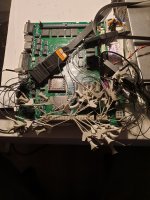Hi,
Would anyone know most common reason for /BERR to be asserted for LCIII 68030 CPU? Obviously no boot, no sound, no picture but there's life on the bus. /HALT /RESET are not asserted, I see on oscilloscope activity on ROM data pins as well as CPU/DRAM R/W pin. Without logic analyser no chance to check any timing.
I see also /ECS & /AS are alive flipping states but /BR & /BG are dead. Honestly looks similar to 68000 machines with dead ram (like Atari ST). I don't have ram to swap it out but is this common fault for these machines?
Not sure how to check if (which) external device CPU is calling for that would fail to respond causing a timeout. /STERM & /DSACK0 change states while /DSACK1 stays high all the time. Which signal to check next to see what's happening? DSACK1 staying high looks like [SIZE=23.68px]Long-Word Operand [/SIZE][SIZE=23.68px]Write[/SIZE] on 8 bit port and /DBEN is changing states too. /RMC stays high so that is not Read Modify Write cycle.
Would anyone know most common reason for /BERR to be asserted for LCIII 68030 CPU? Obviously no boot, no sound, no picture but there's life on the bus. /HALT /RESET are not asserted, I see on oscilloscope activity on ROM data pins as well as CPU/DRAM R/W pin. Without logic analyser no chance to check any timing.
I see also /ECS & /AS are alive flipping states but /BR & /BG are dead. Honestly looks similar to 68000 machines with dead ram (like Atari ST). I don't have ram to swap it out but is this common fault for these machines?
Not sure how to check if (which) external device CPU is calling for that would fail to respond causing a timeout. /STERM & /DSACK0 change states while /DSACK1 stays high all the time. Which signal to check next to see what's happening? DSACK1 staying high looks like [SIZE=23.68px]Long-Word Operand [/SIZE][SIZE=23.68px]Write[/SIZE] on 8 bit port and /DBEN is changing states too. /RMC stays high so that is not Read Modify Write cycle.
Last edited by a moderator:

